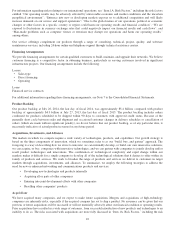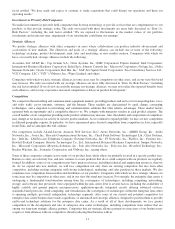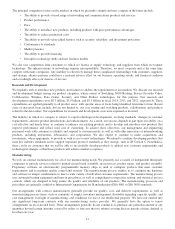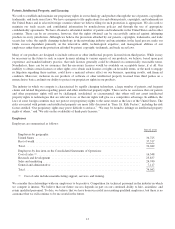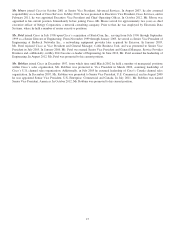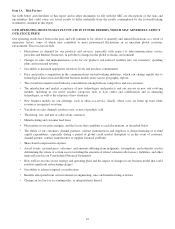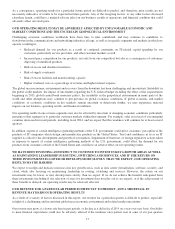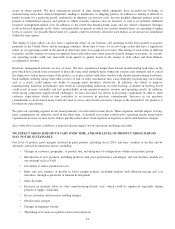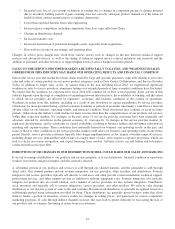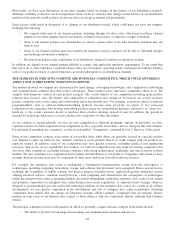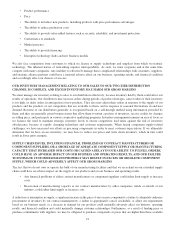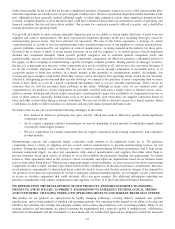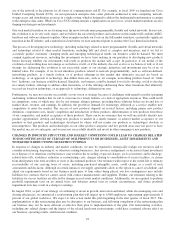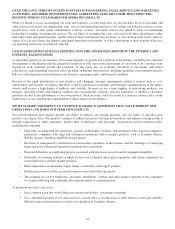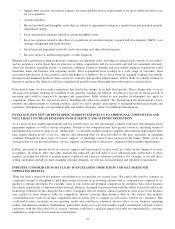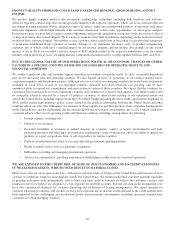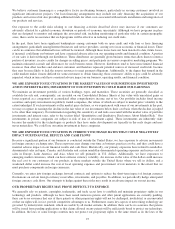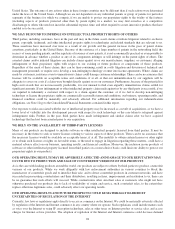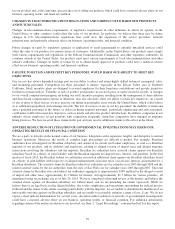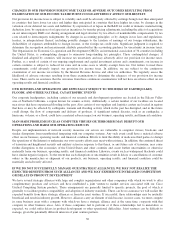Cisco 2014 Annual Report Download - page 28
Download and view the complete annual report
Please find page 28 of the 2014 Cisco annual report below. You can navigate through the pages in the report by either clicking on the pages listed below, or by using the keyword search tool below to find specific information within the annual report.Historically, we have seen fluctuations in our gross margins based on changes in the balance of our distribution channels.
Although variability to date has not been significant, there can be no assurance that changes in the balance of our distribution
model in future periods would not have an adverse effect on our gross margins and profitability.
Some factors could result in disruption of or changes in our distribution model, which could harm our sales and margins,
including the following:
• We compete with some of our channel partners, including through our direct sales, which may lead these channel
partners to use other suppliers that do not directly sell their own products or otherwise compete with them
• Some of our channel partners may demand that we absorb a greater share of the risks that their customers may ask
them to bear
• Some of our channel partners may have insufficient financial resources and may not be able to withstand changes
and challenges in business conditions
• Revenue from indirect sales could suffer if our distributors’ financial condition or operations weaken
In addition, we depend on our channel partners globally to comply with applicable regulatory requirements. To the extent that
they fail to do so, that could have a material adverse effect on our business, operating results, and financial condition. Further,
sales of our products outside of agreed territories can result in disruption to our distribution channels.
THE MARKETS IN WHICH WE COMPETE ARE INTENSELY COMPETITIVE, WHICH COULD ADVERSELY
AFFECT OUR ACHIEVEMENT OF REVENUE GROWTH
The markets in which we compete are characterized by rapid change, converging technologies, and a migration to networking
and communications solutions that offer relative advantages. These market factors represent a competitive threat to us. We
compete with numerous vendors in each product category. The overall number of our competitors providing niche product
solutions may increase. Also, the identity and composition of competitors may change as we increase our activity in newer
product categories such as data center and collaboration and in key growth areas. For example, as products related to network
programmability, such as software-defined-networking products, become more prevalent, we expect to face increased
competition from companies who develop networking products based on commoditized hardware, referred to as “white box”
hardware, to the extent customers decide to purchase those product offerings instead of ours. In addition, the growth in
demand for technology delivered as a service enables new competitors to enter the market.
As we continue to expand globally, we may see new competition in different geographic regions. In particular, we have
experienced price-focused competition from competitors in Asia, especially from China, and we anticipate this will continue.
For information regarding our competitors, see the section entitled “Competition” contained in Item 1. Business of this report.
Some of our competitors compete across many of our product lines, while others are primarily focused in a specific product
area. Barriers to entry are relatively low, and new ventures to create products that do or could compete with our products are
regularly formed. In addition, some of our competitors may have greater resources, including technical and engineering
resources, than we do. As we expand into new markets, we will face competition not only from our existing competitors but
also from other competitors, including existing companies with strong technological, marketing, and sales positions in those
markets. We also sometimes face competition from resellers and distributors of our products. Companies with whom we have
strategic alliances in some areas may be competitors in other areas, and in our view this trend may increase.
For example, the enterprise data center is undergoing a fundamental transformation arising from the convergence of
technologies, including computing, networking, storage, and software, that previously were segregated. Due to several factors,
including the availability of highly scalable and general purpose microprocessors, application-specific integrated circuits
offering advanced services, standards based protocols, cloud computing and virtualization, the convergence of technologies
within the enterprise data center is spanning multiple, previously independent, technology segments. Also, some of our current
and potential competitors for enterprise data center business have made acquisitions, or announced new strategic alliances,
designed to position them to provide end-to-end technology solutions for the enterprise data center. As a result of all of these
developments, we face greater competition in the development and sale of enterprise data center technologies, including
competition from entities that are among our long-term strategic alliance partners. Companies that are strategic alliance
partners in some areas of our business may acquire or form alliances with our competitors, thereby reducing their business
with us.
The principal competitive factors in the markets in which we presently compete and may compete in the future include:
• The ability to provide a broad range of networking and communications products and services
20


